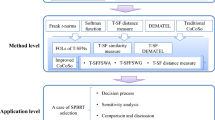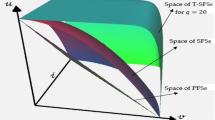Abstract
The process of decision-making in any knowledge-based system inherits a lot of uncertainty in the form of imprecise, incomplete, and inexact information with partial contents where the systematic aggregation of the information plays a vital role. In the present communication, a new kind of fuzzy hypersoft set termed as T-spherical fuzzy hypersoft set has been proposed with various aggregation operators for the decision-making process of renewable energy source selection. Two different types of aggregation operators (arithmetic/geometric) for the T-spherical fuzzy hypersoft sets (TSFHSSs) have been studied along with various properties and important results. Further, an algorithm utilizing the proposed operators for solving the decision-making selection problem has been provided for obtaining the best solution for the renewable energy source selection problem. Some advantageous remarks have also been listed for better understanding and readability.

Similar content being viewed by others
Data availability
Enquiries about data availability should be directed to the authors.
References
Wang Y, Xu L, Solangi YA (2020) Strategic renewable energy resources selection for Pakistan: based on SWOT-fuzzy AHP approach. Sustain Cities Soc 52:101861
Kong Y, Feng C, Yang J (2020) How does China manage its energy market? A perspective of policy evolution. Energy Policy 147:111898
Dhumras H, Bajaj RK (2023) On assembly robotic design evaluation problem using enhanced quality function deployment with \(q\)-rung orthopair fuzzy set theoretic environment. J Inf Sci Eng 39(3):623–636
Molodtsov D (1999) Soft set theory first results. Comput Math Appl 37(4–5):19–31
Maji PK, Biswas R, Roy AR (2001) Fuzzy soft sets. J Fuzzy Math 9:589–602
Maji PK, Biswas R, Roy AR (2001) Intuitionistic fuzzy soft sets. J Fuzzy Math 9(3):677–692
Garg H, Arora R (2020) TOPSIS method based on correlation coefficient for solving decision-making problems with intuitionistic fuzzy soft set information. AIMS Math 5:2944–2966
Peng X, Yang Y, Song J (2015) Pythagorean fuzzy soft set and its application. Comput Eng 41:224–229
Zulqarnain RM, Xin XL, Garg H, Khan WA (2021) Aggregation operators of Pythagorean fuzzy soft sets with their application for green supplier chain management. J Intell Fuzzy Syst 40:5545–5563
Riaz M, Salabun W, Athar Farid HM, Ali N, Watrobski J (2020) A robust q-rung orthopair fuzzy information aggregation using Einstein operations with application to sustainable energy planning decision management. Energies 13(9):2155
Ohlan A (2022) Multiple attribute decision-making based on distance measure under Pythagorean fuzzy environment. Int J Inf Technol 14:2205–2217
Sharma R, Singh U (2021) Fuzzy based energy efficient clustering for designing WSN-based smart parking systems. Int J Inf Technol 13:2381–2387
Lekhraj Kumar A, Kumar A (2022) An approach based on modified multiple attribute decision making for optimal node deployment in wireless sensor networks. Int J Inf Technol 14:1805–1814
Dani D, Agrawal G (2021) Evaluating the quality of Indian school education board’s websites using multi-criteria decision-making models. Int J Inf Technol 13:1–9
Wang L, Li N (2019) Continuous interval-valued Pythagorean fuzzy aggregation operators for multiple attribute group decision making. J Intell Fuzzy Syst 36:6245–6263
Garg H (2017) Some picture fuzzy aggregation operators and their applications to multicriteria decision-making. Arab J Sci Eng 42:5275–5290
Dhumras H, Bajaj RK (2022) On prioritization of hydrogen fuel cell technology utilizing bi-parametric picture fuzzy information measures in VIKOR and TOPSIS decision-making approaches. Int J Hydrog Energy. https://doi.org/10.1016/j.ijhydene.2022.09.093
Rani P, Mishra AR, Pardasani KR, Mardani A, Liao H, Streimikiene D (2019) A novel VIKOR approach based on entropy and divergence measures of Pythagorean fuzzy sets to evaluate renewable energy technologies in India. J Clean Prod 238:117936
Wu Y, Xu C, Ke Y, Tao Y, Li X (2019) Portfolio optimization of renewable energy projects under the type-2 fuzzy environment with a sustainability perspective. Comput Ind Eng 133:69–82
Yuan J, Li C, Li W, Liu D, Li X (2018) Linguistic hesitant fuzzy multi-criterion decision-making for renewable energy: a case study in Jilin. J Clean Prod 172:3201–3214
Dincer H, Yuksel S (2019) Multidimensional evaluation of global investments on renewable energy with the integrated fuzzy decision-making model under the hesitancy. Int J Energy Res 43(5):1775–1784
Dhumras H, Bajaj RK (2022) On renewable energy source selection methodologies utilizing picture fuzzy hypersoft information with choice and value matrices. Scientia Iran. https://doi.org/10.24200/SCI.2022.60529.6847
Ashraf S, Abdullah S, Mahmood T, Ghani F, Mahmood T (2019) Spherical fuzzy sets and their applications in multi-attribute decision-making problems. J Intell Fuzzy Syst 36:2829–2844
Smarandache F (2018) Extension of soft set to hypersoft set, and then to plithogenic hypersoft set. Neutrosophic Sets Syst 22(1):168–170
Yolcu A, Smarandache F, Ozturk TY (2021) Intuitionistic fuzzy hypersoft sets. Commun Fac Sci Univ Ank Ser A1 Math Stat 70(1):443–455
Zulqarnain RM, Xin XL, Saeed MA (2021) A development of Pythagorean fuzzy hypersoft set with basic operations and decision-making approach based on the correlation coefficient. Theory and application of hypersoft set, vol 5. Pons Publishing House Brussels, Brussels, pp 85–106
Zadeh LA (1965) Fuzzy sets. Inf Control 8(3):338–353
Coung B (2014) Picture fuzzy sets. J Comput Sci Cybern 30(4):409–420
Acknowledgements
We are very much thankful to the Editorial Office and anonymous reviewers for suggesting the points/mistakes which have been well implemented/corrected for the necessary improvement of the manuscript. We sincerely acknowledge our deep sense of gratitude to the Editorial office and reviewers for giving their valuable time to the manuscript.
Funding
The authors declare that the research carried out in this article has no source of funding.
Author information
Authors and Affiliations
Contributions
Monika, RKB and AS equally contributed to the design and implementation of the research, to the analysis of the results, and to the writing of the manuscript.
Corresponding author
Ethics declarations
Conflict of interest
The authors declare that they have no known competing financial interests or personal relationships that could have appeared to influence the work reported in this paper.
Ethical approval
This article does not contain any studies with human participants or animals performed by any of the authors.
Informed consent
This article does not contain any studies with humans.
Rights and permissions
Springer Nature or its licensor (e.g. a society or other partner) holds exclusive rights to this article under a publishing agreement with the author(s) or other rightsholder(s); author self-archiving of the accepted manuscript version of this article is solely governed by the terms of such publishing agreement and applicable law.
About this article
Cite this article
Monika, Bajaj, R.K. & Sharma, A. On some new aggregation operators for T-spherical fuzzy hypersoft sets with application in renewable energy sources. Int. j. inf. tecnol. 15, 2457–2467 (2023). https://doi.org/10.1007/s41870-023-01258-y
Received:
Accepted:
Published:
Issue Date:
DOI: https://doi.org/10.1007/s41870-023-01258-y




